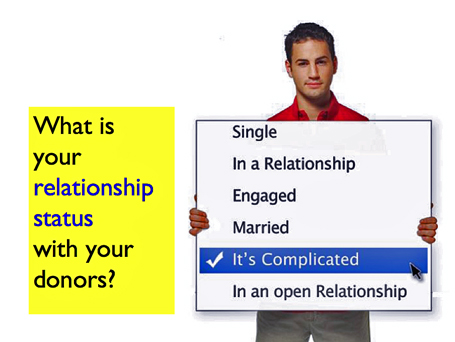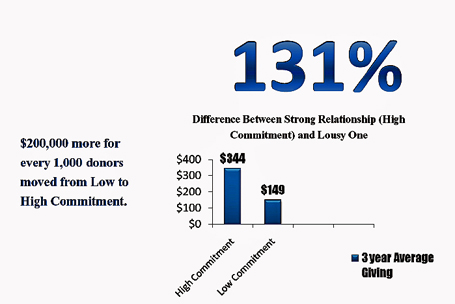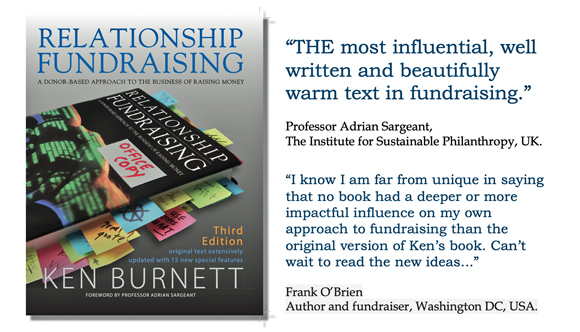|
They’ve developed a model for calculating the commitment of your donors and, from this, a way of ascribing to each of your donors a commitment score. They’ve also worked out the average annual difference in income from a committed donor over one with no sense of loyalty (a whopping 131 per cent more, since you ask). They’ve sensibly linked acquisition and retention and worked out the key factor that influences retention... Books by Ken.
And also a special
|
An older, experienced fundraiser was showing a new, fresh and eager young fundraiser the ropes. ‘To succeed at fundraising my boy,’ the older fundraiser said with gravitas as they strolled around the donor service department, ‘you have to be committed. Mere involvement is not enough. If you want to make something of this career you have chosen, you must be committed.’ The young tyro was puzzled. ‘But, what’s the difference, old timer? Surely involvement and commitment are pretty much the same thing?’ The voice of experience responded with conviction. ‘Ah ha! Not the same thing at all, young fellow, not at all. To understand the difference between commitment and mere involvement you have to understand the difference between bacon and eggs. ‘Bacon and eggs?’ cried the perplexed youth. ‘Yes’, retorted the sage. ‘Bacon and eggs. In bacon and eggs, the hen is involved. But the pig is committed.’ There can have been no more useless argument among fundraisers over the past two decades than the one about whether or not we should be building mutually beneficial relationships with our donors or merely mailing, telephoning and otherwise soliciting them ‘til they bleed’. This latter paradigm, the ‘churn and burn’ school of fundraising, never had even the stump of a leg to stand on in the face of logic, experience and all that donors tell us. Nevertheless, it is the paradigm that holds sway in most fundraising organisations to this day. Our shortsightedness as a sector is as baffling as it is persistent. Perhaps the paradigm persists because no one, so far, has come along and shown us, convincingly, just how much our snatch and grab philosophy is costing us. Thankfully, this seems set to change. For along have come seasoned fundraiser, campaigner and Agitator Roger Craver and his compadre Kevin Schulman, who’s something of a wizard with data. Together this pair has developed a model for calculating the commitment of your donors and, from this, a way of ascribing to each of your donors a commitment score. Someone should. So far, so good. But there’s more. They’ve also worked out the average annual difference in income to you from a committed donor over one with no sense of loyalty (a whopping 131 per cent more, since you ask – there’s big money at stake here). And they’ve worked out the key factor that influences retention. They’ve sensibly linked acquisition and retention (many fundraisers focus everything on the former while foolishly neglecting the latter). In short, Roger and Kevin have treated donor relationship development to the rigorous assessment that its massive importance deserves. For this, they deserve our gratitude. Only a fool will ignore their findings (OK, I’m getting old. I haven’t got time to pussyfoot around on this issue any longer. Nothing costs our fine voluntary sector and all the good works it does more than fundraisers’ neglect of donor relationship development. I no longer care who I insult in getting that point across.) Is this kind of thing likely to be of value for the serious fundraiser? You bet. It’s worth at least Roger and Kevin’s combined weight in precious metal. It’s not the first such effort of course and it won’t be the last. But it’s a sophisticated step forward and it does show, convincingly, why any fundraiser today would be simply certifiable to fail to understand and act upon these findings. Rather than comment in detail on their analysis I've sought their permission to make the executive summary of the first DonorVoice commitment report available for you to download here. This therefore is a DonorVoice report, prepared by them (and so, of course, not subject to the rigours of SOFII’s editorial processes and ultimate conversion from the original American into ‘English’ English). It is no less valuable as a result. I’ve not checked their methodology and cannot comment on the robustness of their maths – that I leave to others more numerate than I. But the overall validity of their conclusions is unarguable. For example, take the claim, ‘For every thousand donors moved from low to high commitment, expect $200,000 in increased revenue’. Though DonorVoice asserts that it can validate the figure, I can’t. But it sounds about right. And for sure, it’s a lot of money, more than enough to be worth doing something about. What matters most here though is the conclusion that commitment is the big thing. That and the ability to compare commitment levels of individual donors, groups of donors and entire donor files of organisations, and to rank them consistently. To have a ‘top 50’ of nonprofits ranked by the commitment of their donors is a breakthrough. You now know what to do to nudge your nonprofit up that list. To be able to delve into your organisation’s donor files and identify where you’re doing well and where you’re falling short, well, that strikes me as near priceless information that should underpin everything for you and your fundraising colleagues. Particularly I recommend the seven key drivers of donor commitment and the ideas banks that accompany them. To anyone who thinks all this is mere common sense, reflect please on the fact that common sense remains very rare in our sector, and elsewhere too. If you would steal a march on your competitors all you have to do is to put these ideas into practice now. Nothing will more quickly and more surely get you ahead of the game. For most of your competitors haven’t cottoned on to this common sense yet. Roger Craver can be contacted c/o the Agitator. Kevin Schulman at DonorVoice will answer any specific questions, provide information on downloads, the maths, white papers etc. Kevin’s email address is KSchulman@thedonorvoice.com. © Ken Burnett 2011 This article was originally prepared as a feature for SOFII, see here.
|
There can have been no more useless argument among fundraisers over the past two decades than the one about whether or not we should be building mutually beneficial relationships with our donors or merely mailing, telephoning and otherwise soliciting them ‘till they bleed’.
At the time of writing Ken Burnett is a director of Clayton Burnett Limited, The White Lion Press Limited and he’s a former chairman of the board of trustees at the international development charity ActionAid. He’s author of several books including Relationship Fundraising and The Zen of Fundraising and is managing trustee of SOFII, The Showcase of Fundraising Innovation and Inspiration. For more on Ken’s books please click here.
|






